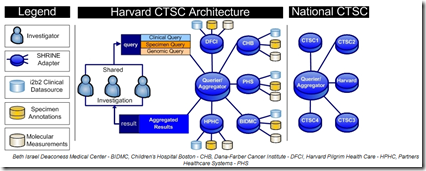You can read Dr.Halamka’s post the the link below, but for those who are not Health IT centric, I’ll do a quick summary here. This is about using data in more than one place and program. In other words if a person was working with payer information and needed related information from an EHR to substantiate the claim information, by aggregating data, this information can become available. If one wanted to have their EHR records put in to a personal health record, this becomes available.
In addition, the business intelligence side of the aggregated data allows for statistical reporting, in other words how good are we doing, and how many of these types of items did we have reported in a designated time frame, and how many did other facilities have in the same time frame for a simple example. Every hospital today needs to be on top of what they are doing and where they stand as information put together in a simple screen format allows this to happen, otherwise we are either just guessing or working for hours on spreadsheets to re-create such data.
Gone are the days where one piece of information rests in one spot, or let’s say it doesn’t do anyone any good if it is not accessible. Also, with a network of business intelligence software, data trails are kept as well, so the time, information accessed, etc. is all recorded so there is no doubt or secret about who was doing what and when.
One part of the network mentioned too is SHRINE, whereby human specimen and genetic information becomes available and these studies with their information are the key to curing and creating disease treatment plans. The end result as you see below goes to a national data base for all to benefit by sharing.
“How can we conduct discovery research across the populations served by Harvard hospitals? Can we do so in a way that protects patient privacy and is respectful of institutional concerns? The Harvard Catalyst's Informatics Program has developed technology in lock step with regulatory and ethical requirements to allow authorized investigators to acquire robust sample sizes across all Harvard-affiliated healthcare institutions. We call this querying system SHRINE (Shared Health Research Information Network). As shown in the diagrams below, there is no central database but rather the SHRINE queries are distributed across each of the participating institutional databases. In this way, each institution maintains autonomy, control, and monitoring of all transactions on behalf of its patients. This plan was predicated on our successfully implementing i2b2 across our member institutions so that we could send out a uniform query to each of these health centers.”
Is there any doubt that scientific and clinical information have come together? I think not, but we just need to encourage those with the purse strings to be sure the money is available both for research and treatment, as if the treatment or drug is not available for patients, then what have we accomplished? This is the approach being done at Harvard and there are other solutions that have a similar architecture with other software products, but the end result is to get all the standardized information where it is needed, to those who can make use so we all benefit. BD
“My definition of traditional data sources that are currently used to measure quality includes administrative claims data aggregated from hospital-based claims databases (for example, BIDMC has an Oracle respository called Casemix), payer-based databases (all have a claims warehouse to support disease management), physician organizations (Beth Israel Deaconess Physicians Organization has worked with Healthcare Data Services to create all payer business intelligence tools ) and health data consortia (such as the Massachusetts Health Data Consortium offers de-identified aggregated claims to enable institutional comparisons)"
New sources of data for quality analysis go beyond administrative data and include EHR, PHR, and Healthcare Information Exchange resources.*Personal Health Records includes those tethered to an EHR, those sponsored by employers, hosted by health plans and vendor-based systems such as Microsoft HealthVault and Google Health enable patients to aggregate, enter, and manage their own data. PHRs may be an appropriate way to measure quality by asking the patients to subscribe/contribute their data to quality measurement organizations. The trusted third party model in Google enables patients to share data with their consent. Some patients may feel altruistic enough to contribute their data for quality measurement.”
Life as a Healthcare CIO: Novel data sources for quality measurement
Related Reading:




0 comments :
Post a Comment